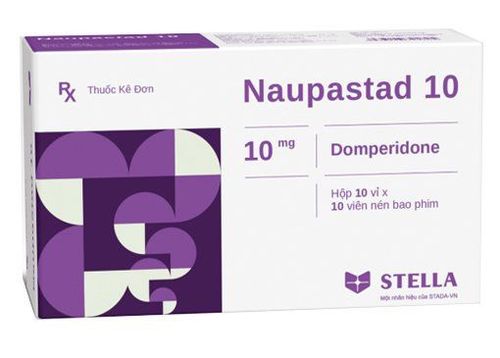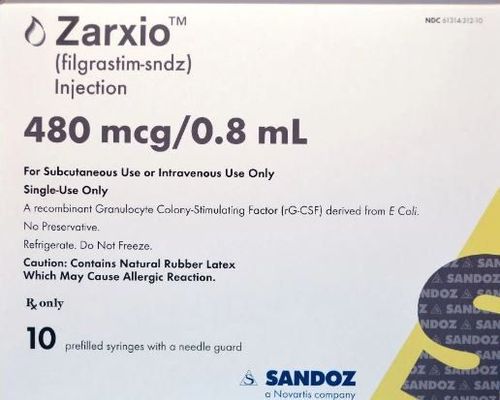This is an automatically translated article.
Nausea and vomiting are very common side effects in patients receiving chemotherapy or radiation therapy or may also occur after some surgeries. Ondansevit is used for short-term treatment to relieve nausea and vomiting caused by medical measures.
1. What is Ondansevit?
Ingredients in each 4ml of Ondansevit 8mg drug solution contains the main active ingredient, Ondansetron (in the form of Ondansetron hydrochloride dihydrate) 8mg.
Ondansetron is a highly selective 5-HT3 receptor antagonist. The exact mechanism of action of this drug in controlling vomiting is currently unknown. Chemotherapy and radiation therapy can induce the nausea and vomiting reflex by activating the vagus nerve through the 5 HT receptor. Ondansetron is thought to inhibit this reflex initiation. When treatments induce vagus nerve activation, they can also induce release of 5HT in the postrema region above the floor of the fourth ventricle and promote vomiting via a central mechanism. Thus, the effect of Ondansetron in the treatment of nausea caused by chemotherapy or radiotherapy may be due to the antagonistic effect of 5HT3 receptors on the peripheral nerves and the central nervous system. This drug is not a dopamine receptor blocker, so there are no extrapyramidal side effects.
2. Indications and contraindications of Ondansevit
Indications: Ondansevit is used to treat the following cases:
Prevention and symptomatic treatment of nausea and vomiting in adults due to chemotherapy or radiation therapy or after surgery. Management of nausea caused by chemotherapy or radiation therapy in children over 6 months of age. Prevention and treatment of vomiting after surgery in children 1 month of age and older. Contraindications: The drug Ondansevit should not be used for the following subjects:
People with a history of allergy to the active ingredient Ondansetron or any of its ingredients. Severe hypersensitivity to any other 5-HT3 antagonists. Concomitant use with Apomorphine.
3. Usage and dosage of Ondansevit
How to use: Ondansevit is indicated for intravenous use or intravenous infusion after being diluted.
Intravenous infusion of this drug must be performed by medical personnel. Before using, you can dilute Ondansevit with solutions such as Nacl 0.9%, Glucose 5% or Mannitol 10% or Ringer Lactate.
Dosage:
Using chemotherapy or radiation to cause vomiting: 8mg slowly intravenously over at least 30 seconds immediately before chemotherapy or radiation therapy. Chemotherapy induces vomiting: 8mg intravenously before chemotherapy. If used with a dose of 8 - 16 mg, it should be diluted with 50 - 100 ml of NaCl solution or other solvents, then need to be infused over at least 15 minutes. Do not exceed 16 mg at a time due to the increased risk of QT prolongation. Chemotherapy-induced vomiting in children 6 months of age and older: Intravenously at a dose of 0.15 mg/kg body weight immediately before chemotherapy. Two more doses may be given, each 4 hours apart. The total dose at one time should not exceed 8mg, the total daily dose should not exceed 32mg. After 12 hours indicated should be taken orally. Prevention of vomiting and treatment of postoperative vomiting in adults: 4mg slow intravenous injection. Prevention of vomiting and treatment of postoperative vomiting in children over 1 month of age: Slow intravenous injection at a dose of 0.1mg/kg body weight, up to a maximum of 4mg before or at the time of induction of anesthesia. Elderly people over 65 years old, people with renal impairment: No dose adjustment is necessary. Patients with moderate to severe hepatic impairment: Do not take this medicine more than 8mg per day. Overdose:
Symptoms: An overdose of the drug can increase the lead to unwanted effects. The most common are visual dysfunction, constipation, low blood pressure, prolongation of the QT interval,... Treatment: Currently, there is no specific antidote. Conduct symptomatic treatment and use supportive measures. In case of overdose, the electrocardiogram should be monitored.
4. Undesirable effects of the drug Ondansevit
The side effects of Ondansevit can occur as follows:
Very common side effects: Headache Common: local reactions such as feeling of heat, redness, pain at the injection site; constipation. Uncommon: Convulsions, movement disorders; hypotension; hiccups; increased liver enzymes; arrhythmia, chest pain. Rare: Hypersensitivity reactions, severe can cause anaphylaxis, angioedema; dizzy ; prolongation of the QT interval; visual disturbances, blurred vision. In addition to the side effects mentioned above, you may also experience other side effects when taking this medicine. If you encounter any unusual symptoms during the course of taking the drug, immediately report it to a medical staff for prompt treatment.
5. Notes when using Ondansevit
To use the drug safely, you need to keep the following in mind:
This is a medicine to be used only under a doctor's prescription. This drug should be administered as an injection for a short period of time and should be converted to an oral form if possible. Before use, inform your doctor about any history of allergies. The drug may cause cross-sensitivity reactions in people with previous hypersensitivity to 5-HT3. Therefore, it is important to pay attention to the history of allergy to these drugs. If the drug is used to cause respiratory side effects, the patient should be informed immediately for treatment, because of the risk of serious hypersensitivity reactions such as anaphylaxis which may follow. The drug causes prolongation of the QT interval and this side effect increases with dose administered. Note that dosage adjustment is appropriate for high-risk individuals or those with a close or family history of prolonged QT interval. Dosage adjustment is essential in hypokalemia and hypomagnesaemia. The drug increases intestinal motility, which requires close monitoring when using this drug in patients with subacute intestinal obstruction. Monitor carefully in patients taking drugs after tonsillectomy, as the drug may mask bleeding. When taking the drug, it is also necessary to closely monitor the liver function indicators in children taking Ondansetron with hepatotoxic drugs. Pregnancy: Because the safety of the drug has not been established for use in pregnant women. Animal studies have shown that Ondansetron is not harmful to pregnancy. But generally not recommended to use the drug for this object. Consult your doctor before intending to use the drug. Nursing mothers: Ondansetron may pass into breast milk. Should not be used for this subject or should stop breastfeeding while taking the drug. Depending on the child's interests and the mother's benefits, appropriate reminders should be made.
6. Drug interactions
The following drug interactions have been reported:
Cardiotoxic drugs, antiarrhythmic drugs, Beta blockers, antibiotics: Increased risk of causing arrhythmias. Drugs that act on Serotonin: Increased risk of Serotonin syndrome. Apomorphine: Marked drop in blood pressure, causing loss of consciousness. Therefore, concomitant use with this drug is contraindicated. Drugs also cause QT prolongation side effects if combined will increase the risk of QT prolongation. Tramadol: If you combine these two drugs, the pain relief effect of Tramadol will be reduced. Phenytoin, Carbamazepine and Rifampicin: Decrease the concentration of Ondansetron in the blood, reducing the drug's effectiveness. To ensure safety when using drugs, you should inform your doctor about the drugs you are taking so that the doctor can consider, to avoid the risk of causing drug interactions.
Hopefully, with the information about the drug, you have understood the effects, how to use it and the notes when using it. This medicine should only be used for a short time and should be used only under the direction of a doctor. During and after taking this medicine, if you notice any unusual problems, tell your doctor right away.













